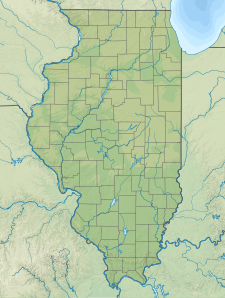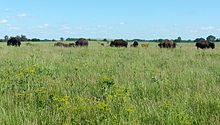
Prairies are ecosystems considered part of the temperate grasslands, savannas, and shrublands biome by ecologists, based on similar temperate climates, moderate rainfall, and a composition of grasses, herbs, and shrubs, rather than trees, as the dominant vegetation type. Temperate grassland regions include the Pampas of Argentina, Brazil and Uruguay, and the steppe of Ukraine, Russia, and Kazakhstan. Lands typically referred to as "prairie" tend to be in North America. The term encompasses the area referred to as the Interior Lowlands of Canada, the United States, and Mexico, which includes all of the Great Plains as well as the wetter, hillier land to the east.

A national grassland is an area of protected and managed federal lands in the United States authorized by Title III of the Bankhead–Jones Farm Tenant Act of 1937 and managed by the United States Forest Service. For administrative purposes, they are essentially identical to national forests, except that grasslands are areas primarily consisting of prairie. Like national forests, national grasslands may be open for hunting, grazing, mineral extraction, recreation and other uses. Various national grasslands are typically administered in conjunction with nearby national forests.

Tallgrass Prairie National Preserve is a United States National Preserve located in the Flint Hills region of Kansas, north of Strong City. The preserve protects a nationally significant example of the once vast tallgrass prairie ecosystem. Of the 400,000 square miles (1,000,000 km2) of tallgrass prairie that once covered the North American continent, less than 5% remains, primarily in the Flint Hills. Since 2009, the preserve has been home to the Tallgrass Prairie bison herd.

The tallgrass prairie is an ecosystem native to central North America. Historically, natural and anthropogenic fire, as well as grazing by large mammals provided periodic disturbances to these ecosystems, limiting the encroachment of trees, recycling soil nutrients, and facilitating seed dispersal and germination. Prior to widespread use of the steel plow, which enabled large scale conversion to agricultural land use, tallgrass prairies extended throughout the American Midwest and smaller portions of southern central Canada, from the transitional ecotones out of eastern North American forests, west to a climatic threshold based on precipitation and soils, to the southern reaches of the Flint Hills in Oklahoma, to a transition into forest in Manitoba.

The Joseph H. Williams Tallgrass Prairie Preserve, in Osage County, Oklahoma near Foraker, Oklahoma, is the largest protected tract of tallgrass prairie in the world. Managed by The Nature Conservancy, the preserve contains 39,650 acres (160 km2) owned by the Conservancy and another 6,000 acres (24 km2) leased in what was the original tallgrass region of the Great Plains that stretched from Texas to Manitoba.

Prairie restoration is a conservation effort to restore prairie lands that were destroyed due to industrial, agricultural, commercial, or residential development. The primary aim is to return areas and ecosystems to their previous state before their depletion.

The Neal Smith National Wildlife Refuge is a federal national wildlife refuge located in Jasper County, Iowa, United States. The refuge, formerly known as Walnut Creek, is named after Congressman Neal Edward Smith, who championed its creation. It seeks to restore the tallgrass prairie and oak savanna ecosystems that once covered most of Iowa. It has a herd of approximately 62 American bison and 19 elk. An initial group of six bison were released in 1996. The bison herd roams an approximately 800-acre enclosure (320 ha).

Joliet Army Ammunition Plant (JOAAP, formerly known as the Joliet Arsenal) was a United States Army arsenal located in Will County, Illinois, near Elwood, Illinois, south of Joliet, Illinois. Opened in 1940 during World War II, the facility consisted of the Elwood Ordnance Plant (EOP) and the Kankakee Ordnance Works (KNK). In 1945, the two were deactivated and combined forming the Joliet Arsenal. The plant was reactivated for the Korean War and renamed Joliet Army Ammunition Plant during the Vietnam War. Production of TNT ended in 1976, and the major plant operations closed shortly after in the late 1970s. The facility briefly revived an automated load-assemble-pack (LAP) artillery shell operation that was managed by the Honeywell Corporation during the Reagan administration in the 1980s before it was finally closed.

The Konza Prairie Biological Station is a 8,616-acre (3,487 ha) protected area of native tallgrass prairie in the Flint Hills of northeastern Kansas. "Konza" is an alternative name for the Kansa or Kaw Indians who inhabited this area until the mid-19th century. The Konza Prairie is owned by The Nature Conservancy and Kansas State University.

Goose Lake Prairie State Natural Area is a 2,537-acre (1,027 ha) state park and listed state nature preserve. More than half of the state park is a tallgrass prairie maintained as a natural area of Illinois. It is located in Grundy County near the town of Morris approximately 50 miles (80 km) southwest of Chicago.
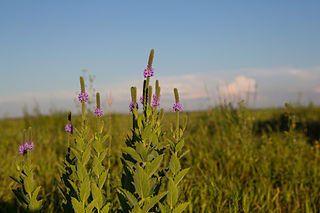
Glacial Ridge National Wildlife Refuge was created on October 12, 2004, the 545th National Wildlife Refuge in the United States. Its creation was the result of cooperation between at least 30 agencies or governmental entities. The creation of the refuge was spearheaded by The Nature Conservancy, and the initial endowment of 2,300 acres (9.3 km2) of land was donated by the Conservancy. In light of its planned final size of 37,756 acres (153 km2), it is described by the US Fish and Wildlife Service as "the largest tallgrass prairie and wetland restoration project in U.S. history."
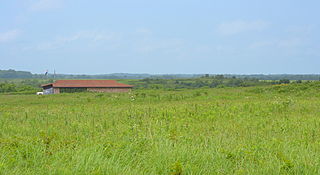
Prairie State Park is a public recreation area encompassing nearly 4,000 acres (1,600 ha) of grasslands and woodlands in Barton County, Missouri. The state park preserves much of the few remaining acres of tallgrass prairie in the state. The park features hiking trails, camping for backpackers, and a nature center. Captive wild bison and elk roam the park. The bison herd contains about 100 individuals as of spring 2021.
The Forest Preserve District of Will County was created by referendum on July 25, 1927, to preserve open spaces in Will County, Illinois, US. The first land acquisition was in 1930. As of December 2010, the District owns or manages 21,916 acres (8,869 ha) of land. Current Will County board members make up a board of commissioners, which oversees the affairs of the Forest Preserve District.
The Tallgrass Prairie bison herd is a population of American bison inhabiting the Tallgrass Prairie National Preserve in central Kansas. It is a public bison herd that has little evidence of cattle introgression.
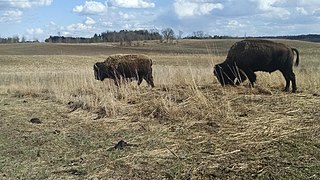
The Nachusa Grasslands is a 3,800 acres (1,500 ha) restored tallgrass prairie near Franklin Grove in Lee County and Ogle County, Illinois. It is managed by The Nature Conservancy staff and volunteers.

The Wetlands Initiative (TWI) is a non-profit conservation organization headquartered in Chicago, Illinois, United States. The Wetlands Initiative works with nonprofit and government partners and local communities to advance wetland restoration and science in the Midwestern United States. The organizational vision of TWI is: "A world with plentiful healthy wetlands improving water quality, climate, biodiversity, and human well-being."

Kankakee Sands is a 10,000-acre (4,000 ha) restored tallgrass prairie in Kankakee County, Illinois and Newton County, Indiana. It is managed by The Nature Conservancy staff and volunteers. The Efroymson Restoration at Kankakee Sands is 8,400 acres (3,400 ha) of prairies and wetlands connecting Willow Slough Fish and Wildlife Area, Beaver Lake Nature Preserve, Conrad Savanna Nature Preserve and Conrad Station Savanna. This creates over 20,000 acres (8,100 ha) of dry, mesic and wet sand prairies, sand blows, sedge meadows, wetlands, and black oak savannas.

The Fermilab bison herd was established in 1969 at the U.S. national laboratory in Batavia, Illinois, about 34 mi (55 km) west of Chicago, under the leadership of physicist, amateur architect and Wyoming native Robert R. Wilson. The herd grazes an 800-acre pasture adjacent to the Fermilab prairie, which sits atop the accelerator's underground Main Ring and Tevatron. The herd usually averages around 25 individuals; as of spring 2022, the head count of the herd was 32 individuals.


